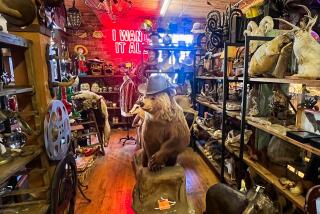Classic Hollywood: Celebrating 50 years of ‘Planet of the Apes’ at USC
When the original “Planet of the Apes” opened 50 years ago, audience watched the sci-fi adventure with shock and awe. Not only because it was exciting and thought-provoking but also for its innovative, Oscar-winning ape makeup designs and the jaw-dropping finale.
“Planet of the Apes,” which was directed by Franklin J. Schaffner and starred Charlton Heston, Linda Harrison, Kim Hunter, Roddy McDowall and Maurice Evans, was so popular that the 20th Century Fox release spawned four sequels — this at a time when sequels were far less routine — plus a live action and animated TV series.
Tim Burton resurrected “Planet of the Apes” with a disappointing 2001 movie. But a reboot film series that looks at the roots of the story, which began in 2011 with “Rise of the Planet of the Apes,” followed by 2014’s “Dawn of the Planet of the Apes” and 2017’s “War for the Planet of the Apes,” have been critical and box office hits.
Just as the original had cutting makeup for the apes, the new films featuring state-of-the-art motion capture CGI of the apes, as well as a brilliant performance by Andy Serkis (Gollum, King Kong) as ape leader Caesar.
Twentieth Century Fox and the USC School of Cinematic Arts are marking this legacy with a year-long celebration that begins Friday with “50 Years of Planet of the Apes,” a free exhibit and retrospective at the university. The screening series kicks off with the 1968 original, followed by a panel discussion, “Legacy of the Planet of the Apes,” featuring Harrison, production designer William Creber and makeup artist Dan Striepeke from the first film and “Dawn” and “War” director Matt Reeves, “Rise” director Rupert Wyatt, trilogy producers Amanda Silver and Rick Jaffa and Dylan Clark.
“I was so blown away by these new films that it reminded me that the original is turning 50 and we should do something,” said Alex Ago, director of programming and special projects at the School of Cinematic Arts, who is moderating the discussion. “There’s a lot of alumni that worked on these films.” Among them are Arthur P. Jacobs, who produced the original, as well as Reeves and Silver.
Collectors provided most of the items for the exhibition, which continues through May 13 at the Hugh Hefner Exhibition Hall at USC.
“I didn’t realize that the Fox archives would be very light in terms of objects and costumes form the original five films,” Ago said. “They certainly have a wonderful photographic archive and plenty of beautiful artwork, design sketches, concept art and posters. Obviously, we took advantage of all the things they did have.”
But none of those were tangible objects. “From the original film, they have maybe a dozen rifles and one bust of Dr. Zaius. Then we faced another problem. [In] the new trilogy, the apes themselves are computer-generated.”
So, the Burton film ended up being a “genuine blessing,” because Colleen Atwood’s costumes “were exquisite, and those were available. And once the word got out the exhibit was happening, I started to get emails left and rights from fans and collectors, some of whom honestly have turned portions of their house into living shrines.’’
The coolest thing in the exhibit, said Ago, is “the side-by-side comparison of the actual plaster molds made by [make-up artists] John Chambers and Dan Striepeke, with the finished product of the prosthetics that would be then applied to the actors’ faces. Then that’s complemented with the photographs of the actors actually getting the makeup allied to them.”
“Everything was new in terms of makeup for the movie,” said Striepeke, who earned Oscar nominations for makeup for 1994’s “Forrest Gump” and 1998’s “Saving Private Ryan.” “We went to BFGoodrich and we went to U.S. Rubber. We went everywhere you know and got all different kinds of formulations. We worked on them, threw them out and started over again.”
And no, he hasn’t seen the three new movies. “Sorry, I know technology has passed my art form and many of my cohorts, but I am not interested.”
Peter Chernin, the producer of those new films, said they investigated many ways to create the apes for “Rise.”
“We explored makeup and prosthetics, which is the way you normally do it,” he said. “We explored live chimps and combinations of some live chimps, some makeup and prosthetics and some CG. We ultimately came to the conclusion that we had to do the entire movie in CG.”
According to Chernin, the issue was that no one had “ever done this level of realistic CG at this point. No one had really attempted to do completely photo-realistic humanoid characters before.”
Weta Digital visual effects artist Joe Letteri, is an Oscar nominee this year for his work on “War for the Planet of the Apes.” He has won Oscars for 2002’s “The Lord of the Rings: The Two Towers,” 2003’s “The Lord of the Rings: The Return of the King,” 2005’s “King Kong” and 2009’s “Avatar.”
“We just had to keep learning as we go,” he said of the three recent “Apes” films. “Fortunately, by the time we did Caesar, we’d done a number of characters and just kept learning as we went.”
Chernin believes there are a number of reasons why “Planet of the Apes” has captivated audiences for the last five decades.
“I would say it is, ironically, the most human of all the science-fiction stories,” he said. “The concept allows you to comment on humanity in ways that are remarkably meaningful to people because it doesn’t force people to confront their own morals or issues directly, because it’s not humans. But it’s close enough that you can make tremendous commentary on humanity in ways that are entertaining and fun.”
#######
“50 Years of Planet of the Apes”
“Planet of the Apes” screening and discussion, 7 p.m. Friday at the Frank Sinatra Hall at the Eileen Norris Cinema Theatre Complex, USC campus. Admission is free, but reservations are required at cinema.usc.edu.Apes.
The “Planet of the Apes” exhibition, Feb. 9-May 13, is in the Hugh Hefner Exhibition Hall in the lobby of the George Lucas Building at the USC School of Cinematic Arts. 8 a.m. to 10 p.m. Monday to Friday and noon to 8 p.m. Saturday and Sunday. Admission is free.
Info: cinema.usc.edu/events/event.cfm?id=20437
More to Read
Only good movies
Get the Indie Focus newsletter, Mark Olsen's weekly guide to the world of cinema.
You may occasionally receive promotional content from the Los Angeles Times.







